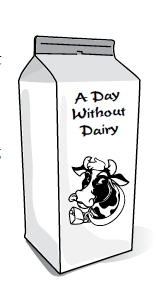A Day Without Dairy
Students create, read, and interpret graphs relating to the economic importance of the dairy industry and are challenged to understand the economic consequences of a day without dairy.
Background
Lesson Activities
Recommended Companion Resources
Credits
Author
Mandi Bottoms | California Foundation for Agriculture in the Classroom
Acknowledgements
This lesson was funded in 2008 by the California Milk Advisory Board and the California Farm Bureau Federation. To meet the needs of California educators, Milk Matters: Discovering Dairy was created to meet the Curriculum Content Standards for California Public Schools. The unit also includes a collection of relevant resources about the dairy industry.
Executive Director: Judy Culbertson
Layout and Design: Imelda Muziom
Standards
Indiana Content Area Standards
-
Social Studies. Grade 3: Economics: Standard 4
Students explain how people in the local community make choices about using goods, services and productive resources; how they engage in trade to satisfy their economic wants and needs; how they use a variety of sources to gather and apply information about economic changes in the community; and how they compare costs and benefits in economic decision making.
- 3.4.1 Economics: Give examples from the local community that illustrate the scarcity of productive resources. Explain how this scarcity requires people to make choices and incur opportunity costs.
-
Social Studies. Grade 4: Economics: Standard 4
Students study and compare the characteristics of Indianas changing economy in the past and present.
- 4.4.4 Economics: Explain that prices change as a result of changes in supply and demand for specific products.
-
English Language Arts.Grade 3.W.1
Write routinely over a variety of time frames and for a range of discipline-specific tasks, purposes, and audiences; apply reading standards to write in response to literature and nonfiction texts.
- Writing Genres.3.W.3.2: Write informative compositions on a variety of topics that a. State the topic, develop a main idea for the introductory paragraph, and group related information together. b. Develop the topic with facts and details. c. Connect ideas within categories of information using words and phrases. d. Usetextfeatures(e.g.,pictures,graphics)whenusefultoaidcomprehension. e. Provide a concluding statement or section.
-
English Language Arts.Grade 3.SL.1
Listen actively and adjust the use of spoken language (e.g., conventions, style, vocabulary) to communicate effectively with a variety of audiences and for different purposes.
- Comprehension.3.SL.3.2: Ask and answer questions about information from a speaker, offering appropriate elaboration and detail.
- Discussion and Collaboration.3.SL.2.1: Engage effectively in a range of collaborative discussions (one-on-one, in groups, and teacher-led) on grade- appropriate topics and texts, building on others ideas and expressing personal ideas clearly.
- Discussion and Collaboration.3.SL.2.2: Explore ideas under discussion by drawing on readings and other information.
- Discussion and Collaboration.3.SL.2.5: Explain personal ideas and understanding in reference to the discussion.
-
English Language Arts.Grade 4.W.1
Write routinely over a variety of time frames and for a range of discipline-specific tasks, purposes, and audiences; apply reading standards to support reflection and response to literature and nonfiction texts.
- Writing Genres: Argumentative, Informative, and Narrative.4.W.3.2: Write informative compositions on a variety of topics that a. Provide an introductory paragraph with a clear main idea. b. Provide supporting paragraphs with topic and summary sentences. c. Provide facts, specific details, and examples from various sources and texts to support ideas and extend explanations. d. Connect ideas using words and phrases. e. Include text features (e.g., formatting, pictures, graphics) and multimedia when useful to aid comprehension. f. Use language and vocabulary appropriate for audience and topic. g. Provide a concluding statement or section.
-
English Language Arts.Grade 4.SL.1
Listen actively and adjust the use of spoken language (e.g., conventions, style, vocabulary) to communicate effectively with a variety of audiences and for different purposes.
- Discussion and Collaboration.4.SL.2.1: Engage effectively in a range of collaborative discussions (one-on-one, in groups, and teacher-led) on grade- appropriate topics and texts, building on others ideas and expressing personal ideas clearly.
- Discussion and Collaboration.4.SL.2.2: Explore ideas under discussion by drawing on readings and other information.
- Discussion and Collaboration.4.SL.2.4: Pose and respond to specific questions to clarify or follow up on information, and make comments that contribute to the discussion and link to the remarks of others.
-
English Language Arts. Grade 5.W.1
Write routinely over a variety of time frames and for a range of discipline-specific tasks, purposes, and audiences; apply reading standards to support reflection and response to literature and nonfiction texts.
- Writing Genres: Argumentative, Informative, and Narrative.5.W.3.2: Write informative compositions on a variety of topics that - a. Introduce a topic; organize sentences and paragraphs logically, using an organizational form that suits the topic. b. Employ sufficient examples, facts, quotations, or other information from various sources and text to give clear support for topics. c. Connect ideas within and across categories using transition words (e.g. therefore, in addition). d. Include text features (e.g. formatting, pictures, graphics) and multimedia when useful to aid comprehension. e. Use appropriate language, vocabulary, and sentence variety to convey meaning; for effect; and to support a tone and formality appropriate to the topic and audience. f. Provide a concluding statement or section related to the information or explanation presented.
-
English Language Arts.Grade 5.SL.1
Listen actively and adjust the use of spoken language (e.g., conventions, style, vocabulary) to communicate effectively with a variety of audiences and for different purposes.
- Discussion and Collaboration.5.SL.2.1: Engage effectively in a range of collaborative discussions (one-on-one, in groups, and teacher-led) on grade- appropriate topics and texts, building on others ideas and expressing personal ideas clearly.
- Discussion and Collaboration.5.SL.2.2: Reflect on and contribute to ideas under discussion by drawing on readings and other resources.
- Discussion and Collaboration.5.SL.2.4: Pose and respond to specific questions by making comments that contribute to the discussion and elaborate on the remarks of others.
